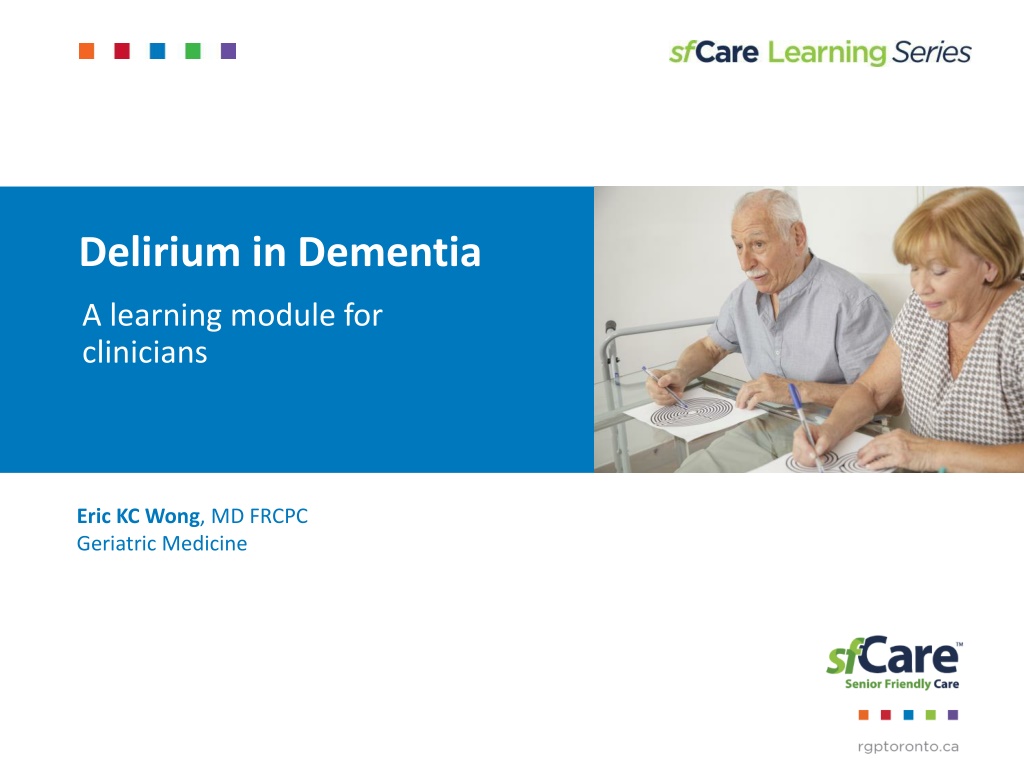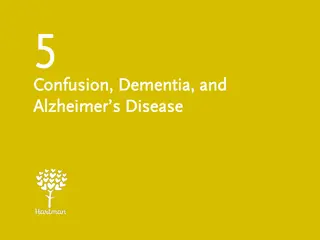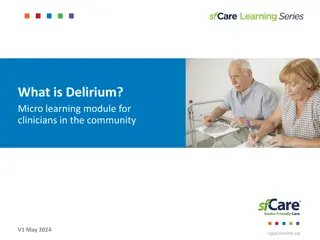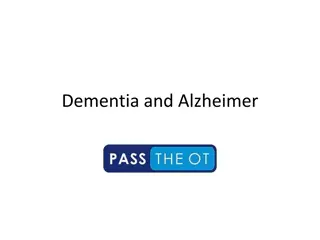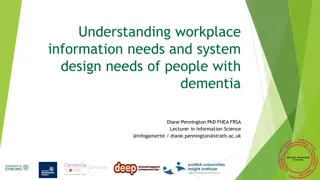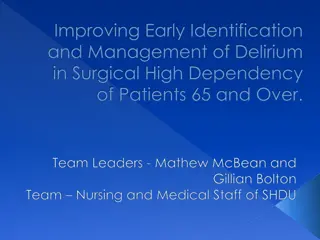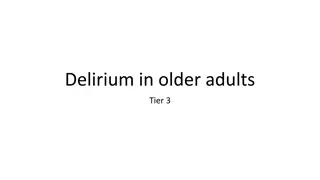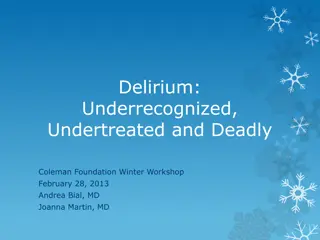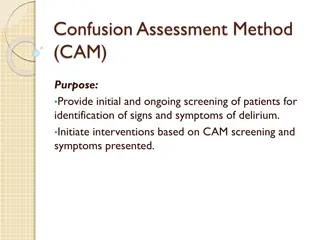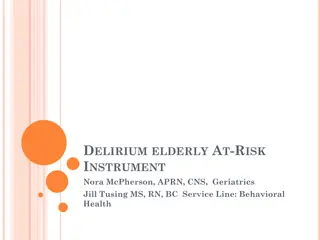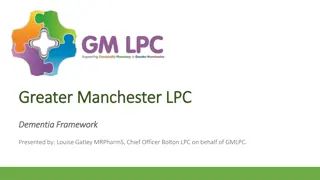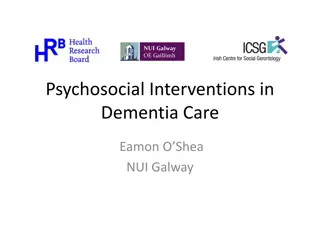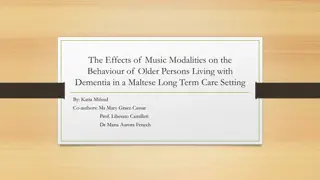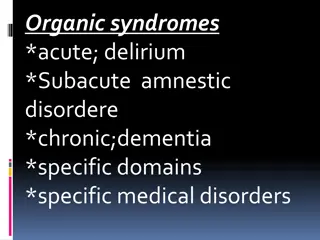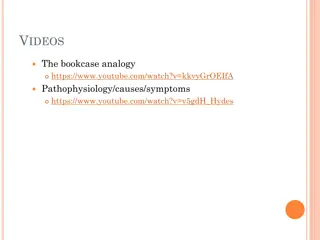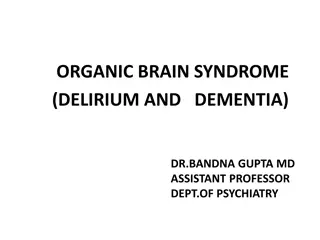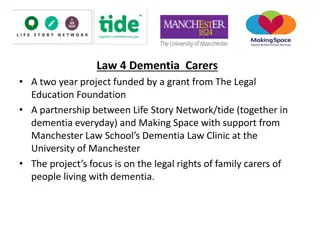Understanding Delirium in Dementia for Clinicians
This learning module provides clinicians with insights into the relationship between delirium and dementia, how to distinguish between the two conditions, practical approaches to assessing delirium in dementia patients, treatment implications, and a structured method for delirium detection using case studies. The module also explores the impact of cognitive impairment, brain vulnerability, and reduced reserve on delirium occurrence. Clinicians learn about cognitive recovery, the effects of insult such as surgery or illness, and how delirium can affect cognition baseline. Additionally, the module discusses the differences in recovery times between patients with shorter, less severe delirium and those with prolonged, more severe delirium, emphasizing the need for a senior-friendly approach in addressing these conditions.
Download Presentation

Please find below an Image/Link to download the presentation.
The content on the website is provided AS IS for your information and personal use only. It may not be sold, licensed, or shared on other websites without obtaining consent from the author. Download presentation by click this link. If you encounter any issues during the download, it is possible that the publisher has removed the file from their server.
E N D
Presentation Transcript
Delirium in Dementia A learning module for clinicians Eric KC Wong, MD FRCPC Geriatric Medicine
This module is part of the sfCare approach This module follows the Delirium introductory module for clinicians. Patient Handout 8.5 x 11 Poster PowerPoint Presentation 2 2
Objectives Objectives 1. Recognize the relationship between delirium and dementia Relationship between delirium and dementia 2. Distinguish between delirium and dementia How to distinguish delirium from dementia 3. Apply a practical approach to assessing delirium in dementia Practical approach to assessment 4. Describe treatment implications Treatment implications 5. Apply a structured approach to delirium detection in dementia using case studies Case studies 6. Explain approaches to delirium in the community Approaches in the community 7. Apply a senior friendly approach to delirium Senior friendly approach Questions NOTE: Diagnosis of dementia is beyond the scope of this module 3
Relationship between delirium and dementia Objectives Delirium is a risk factor for future dementia, but baseline dementia is also a risk factor for delirium incidence Relationship between delirium and dementia Cognitive impairment leads to brain vulnerability and reduced reserve, which increases the likelihood of delirium from a mild precipitant. E.g. change in medication, UTI, pain How to distinguish delirium from dementia Practical approach to assessment Delirium increases dementia risk by unknown mechanisms. Those who experienced delirium have increase brain atrophy. Treatment implications Case studies Clinicopathologic correlates show that patients with dementia after delirium don t exhibit the typical pathologyof Alzheimer s disease or Lewy body dementia, suggesting a separate pathway of neuroinflammation. Approaches in the community Senior friendly approach Questions Lancet Neurol 2015; 14: 823 32 | Brain 2012: 135; 2809 2816 4
Relationship between delirium and dementia Objectives Cognition RECOVERY Relationship between delirium and dementia Insult (Surgery, illness) Those who have delirium have worse cognition at baseline How to distinguish delirium from dementia Those with delirium may not recover to cognitive baseline No delirium Practical approach to assessment Shorter, less severe delirium Those with prolonged delirium take longer to recover and will likely not return to baseline cognition Treatment implications Prolonged, more severe delirium Case studies Approaches in the community Surgical patients: 2 months Medicine patients: 6-12 months Time Day 2 36 months Senior friendly approach Questions Alzheimer s & Dementia 12 (2016) 766-775 | Brain 2012: 135; 2809 2816 | N Engl J Med, 367 (1), 30-9 5
How to distinguish delirium from dementia Objectives Since dementia and delirium both feature disorientation, short term memory loss, hallucinations/delusions, and agitation/restlessness, it s important to learn how to distinguish the two diseases. Relationship between delirium and dementia Alzheimer s disease is the most common type of dementia, and it can be easily separated from delirium because of its insidious slow onset and preservation of attention in the early stages. How to distinguish delirium from dementia Practical approach to assessment Treatment implications Lewy body dementia is a less common type of dementia, but it can mimic delirium because of its fluctuating course and inattention. Case studies Approaches in the community Senior friendly approach Questions Neurology, 54 (11 Suppl 5), S4-9 2000 6
How to distinguish delirium from dementia Delirium Lewy body dementia (DLB) Alzheimer s disease (AD) Objectives Relationship between delirium and dementia Onset Acute Insidious Insidious Course Fluctuating Fluctuating (but not always), progressive Progressive How to distinguish delirium from dementia Attention Always inattentive Periods of inattention Attentive in early-to- moderate stages in the disease Practical approach to assessment Alertness / motor subtype May be drowsy (hypoactive) or restless/agitated (hyperactive) Usually drowsy (but may be restless/agitated) Usually restless/agitated Treatment implications Case studies Cognitive Testing Impaired across all domains due to inattention or mainly in executive function Impaired mainly in executive function and visuospatial domains early in disease Impaired mainly in delayed recall early in the disease Approaches in the community Senior friendly approach Questions J Neurol Neurosurg Psychiatry, 75 (3), 382-7 Mar 2004.; J Neuropsychiatry Clin Neurosci, 25 (2), E27-8 Spring 2013; Neurology 2017; 89 (1) July 04 7
Clinical description of the fluctuations Delirium DLB AD Deviates from the patient s usual behavioural patterns, either by timing or severity. Fluctuations may last hours or days and does not follow a pattern (unlike sundowning). Sundowning is NOT considered fluctuations. Sundowning is a pattern of worsening neuropsychiatric symptoms in the afternoon/evening hours in patients with dementia Sundowning usually occurs in the moderate-to-late stages of the disease Fluctuations have been described in detail previously and are typically delirium-like, occurring as spontaneous alterations in cognition, attention, and arousal not due to a precipitating factor Associated with precipitant (change in medications, infections, hospitalization etc.) Characteristics of fluctuations: Include waxing and waning episodes of behavioral inconsistency, incoherent speech, variable attention, or altered consciousness that involves staring or zoning out. Direct questioning of an informant about fluctuations may not reliably discriminate DLB from AD, but questions about daytime drowsiness, lethargy, staring into space, or episodes of disorganized speech do. 8
Practical approach to assessment Objectives Relationship between delirium and dementia 1. Check with an informant How to distinguish delirium from dementia 2. Look for fluctuations 3. Assess for inattention Practical approach to assessment Treatment implications Case studies Approaches in the community Senior friendly approach Questions 9
Practical approach to assessment Objectives 1.Check with an informant 2. Look for fluctuations Relationship between delirium and dementia The most reliable way to determine whether someone with dementia has delirium is by an informant (e.g. family, caregiver) who knows the patient well. Do you think [name of patient] has been more confused lately? (ref: Single Question in Delirium, 91% sensitivity for delirium) If family not available, call the nursing home, ask the LHIN case manager, or anyone else who interacts with the patient regularly. Look for fluctuations. If the patient experiences periods of lucidity in between episodes of increased confusion, the patient likely has delirium. How to distinguish delirium from dementia Practical approach to assessment Treatment implications Case studies Approaches in the community Senior friendly approach Questions Age & Ageing 2016 45(6):832-837 10
Practical approach to assessment Objectives 3. Assess for inattention Relationship between delirium and dementia Since inattention is always present in delirium, you can rule out delirium in someone who is attentive. You can use a bedside test to determine whether someone is inattentive. How to distinguish delirium from dementia Tests Sensitivity (%) Specificity (%) Practical approach to assessment Serial 7s 95.7 13.7 Treatment implications Serial 3s 87.0 47.0 Case studies Months of the year backwards 82.6 62.5 Approaches in the community Days of the week backwards 47.8 85.1 Senior friendly approach Counting 1-10 17.4 91.1 Questions Int Psychogeriatr. 2016 Aug;28(8):1293-301. | Age Ageing. 2015 May;44(3):537-8. 11
Cut off for months of the year backwards Objectives 3. Assess for inattention Relationship between delirium and dementia When asking the patient to recite the months of the year backwards from December, different experts use different cut offs to define inattention. The patient should at least be able to get to July. How to distinguish delirium from dementia Practical approach to assessment Cutoff Sensitivity (%) Specificity (%) Derived from <5/12 (July) 82.0 66.0 Adamis et al. 2016 Treatment implications <5/12 (July) 91.3 49.7 Hendry et al. 2016 Case studies <7/12 (May) 93.1 49.8 4AT Approaches in the community <12/12 (All) 82.6 62.5 Voyer et al. 2016 Senior friendly approach MOTYF 26.1 89.3 Voyer et al. 2016 Questions 12
Treatment implications Objectives Delirium care is attentive, patient-centred care. There is no harm applying non-pharmacologic delirium care strategies to someone with dementia, so when in doubt, treat the patient for delirium. Relationship between delirium and dementia Recall the management strategies from the previous module, which includes: How to distinguish delirium from dementia Frequent reorientation with calendar/clock/window visible Adequate hydration and nutrition Mobilization including sitting in a chair for meals Put on (clean) glasses and hearing aids Ensure good sleep Non-caffeinated warm drink before bed Encourage family to be present if possible, and provide information on how they can help Practical approach to assessment Treatment implications Case studies Approaches in the community Senior friendly approach Questions 13
Treatment implications Objectives Patients with parkinsonism Relationship between delirium and dementia Detecting parkinsonism is particularly important when treating delirium. The principal harm is the use of high potency antipsychotics in a patient with parkinsonism. Parkinson s disease (PD) symptoms on exam: Slow movements Little facial expression (hypomimia) Slow blink rate Increased tone on passive range of motion Slow, shuffling gait with stooped posture and little arm swing Unilateral rest tremor (present in 70% of PD patients) How to distinguish delirium from dementia Practical approach to assessment Patients with primary Parkinson s disease or Lewy body dementia are sensitive to antipsychotics because dopamine (D2) antagonism will lead to worsening of rigidity and parkinsonism, which will likely lead to more discomfort and agitation. Treatment implications Case studies Approaches in the community Everyone should check the patient s medical history for a diagnosis of Parkinson s or Lewy body dementia. The medical expert should learn to examine a patient for signs of Parkinson s. Senior friendly approach Questions 14
Treatment implications Objectives Patients with parkinsonism Relationship between delirium and dementia In patients with parkinsonism who need pharmacologic therapy for delirium, low dose quetiapine should be tried first (12.5mg po qhs or bid depending on timing of symptoms). Experienced clinicians may use: Clozapine: need to monitor for agranulocytosis (1-2%) with serial CBCs Pimavanserin: antagonist of 5-HT2A receptor with no D2 activity. Clinical trials have shown no increase in rigidity, but the medication is not approved in Canada or Europe yet. If the patient is on dopaminergic drugs (e.g. levodopa, pramipexole), consider lowering doses slowly if contributory to symptoms. How to distinguish delirium from dementia Practical approach to assessment Treatment implications Case studies Approaches in the community Senior friendly approach Questions Expert Opin Pharmacother, 19 (5), 499-505 Apr 2018 15
Case Study 1: Mr. J Diagnosing a delirium with underlying dementia Objectives Relationship between delirium and dementia How to distinguish delirium from dementia Mr. J is an 80 year old male who was brought by his daughter to the hospital for visual hallucinations and confusion. Practical approach to assessment Treatment implications How will you start your assessment? Case studies Approaches in the community Senior friendly approach Questions 16 16
Case Study 1: Mr. J. Objectives Relationship between delirium and dementia How will you start your assessment? How to distinguish delirium from dementia 1. 2. 3. Is this delirium? Is there underlying dementia? If it is delirium, what s the precipitant? refer to first module How to treat? Practical approach to assessment 4. Treatment implications Case studies Approaches in the community Senior friendly approach Questions 17 17
Case Study 1: Mr. J Is this delirium? Is there underlying dementia? It s common for delirium to be the first presentation of dementia because caregivers may attribute symptoms of early dementia to normal aging. Objectives Relationship between delirium and dementia Check with an informant How to distinguish delirium from dementia Speak to an informant who knows the patient well (such as family or caregiver). Ask the informant if the patient appears more confused than usual. Practical approach to assessment Q When did the confusion start? He has been confused for the last 2 years, getting worse. He frequently forgets conversations and where he put things. Treatment implications Case studies Q What was the patient s cognitive baseline 1 week or 1 month ago? He was much better a few days ago! The hallucinations only started about 2 days ago. He also started feeling short of breath at the same time. Approaches in the community Senior friendly approach Q Does the patient have diagnosed dementia? If so what type? No, at first we thought it was just because he s getting old. Do you think he has dementia? Questions 18 18
Case Study 1: Mr. J Is this delirium? Objectives Relationship between delirium and dementia Assess for inattention + orientation Speak to the patient to get a sense of orientation and attention level. Q Ask the patient to recite the months of the years backwards from December Patient gets stuck at November Q Ask the patient for orientation to place and time, and compare this with his baseline via informant history (if available). He is disoriented to time and place Look for fluctuations Check the nurse s or physician s charting to see if the patient s mental status is fluctuating. How to distinguish delirium from dementia Practical approach to assessment CAM criteria Treatment implications Case studies Approaches in the community Senior friendly approach Questions 19 19
Summarizing the approach to criteria 1 and 2 from CAM Objectives Relationship between delirium and dementia How to distinguish delirium from dementia Practical approach to assessment Treatment implications Case studies Approaches in the community Senior friendly approach Questions 20 20
Case Study 1: Mr. J Mr. J appears to have delirium superimposed on dementia Objectives Relationship between delirium and dementia There s an acute change on a background of chronic progressive cognitive impairment. Tests for inattention were positive and the patient had disorganized thinking (disorientation and hallucinations). CAM criteria fulfilled How to distinguish delirium from dementia Practical approach to assessment Treatment implications Case studies Approaches in the community After the delirium resolves, you refer the patient to a geriatrician for dementia diagnosis. The geriatrician sends you a consultation note thanking you for identifying an underlying dementia syndrome. The patient was diagnosed with Alzheimer s disease. Senior friendly approach Questions 21 21
Case Study 2: Mrs. C Treatment of delirium Objectives You are called to examine an 85 year old female who was admitted to hospital for heart failure. She developed delirium on day 2 of her hospital stay and is agitated, trying to pull out her IV and striking out at the nurses. After optimizing the patient s medications, pain, dyspnea, volume status and electrolytes, she s still agitated and at risk of harming herself and others. An antipsychotic is required to prevent further harm and restraint use. You proceed to the antipsychotic checklist from the previous module. Relationship between delirium and dementia How to distinguish delirium from dementia Practical approach to assessment Treatment implications Case studies Approaches in the community Senior friendly approach Questions 22 22
If a patient requires antipsychotics, rule out parkinsonism Objectives Relationship between delirium and dementia How to distinguish delirium from dementia Practical approach to assessment Treatment implications Case studies Approaches in the community Senior friendly approach Questions 23 23
Case Study 2: Mrs. C - Resolution Objectives When you examine Mrs. C, you find that she has some rigidity in her arms and legs and her voice appears quiet. Her niece also tells you that the she has been slowing in movement and walking for the last 5 years and getting worse. You determine that Mrs. C likely has parkinsonism, and document that you will avoid giving high potency antipsychotics (e.g. haloperidol or risperidone). You write an order for quetiapine 12.5mg po qhs. Relationship between delirium and dementia How to distinguish delirium from dementia Practical approach to assessment Treatment implications Case studies Approaches in the community The patient s delirium resolves gradually over the next week, and you discontinue the quetiapine prior to discharge. You refer Mrs. C to a geriatrician or neurologist for assessment of Parkinson s disease and cognitive testing. Senior friendly approach Questions 24 24
Approaches in the community Objectives Delirium typically requires in hospital investigation and treatment. Relationship between delirium and dementia Following an episode of delirium, community providers should screen for cognitive impairment after waiting for full resolution (may take months). How to distinguish delirium from dementia Although the Canadian Task Force for Preventative Health Care recommends against screening asymptomatic older adults for dementia, patients who have experienced delirium should be screened for dementia because they are not asymptomatic . Practical approach to assessment Treatment implications Case studies Approaches in the community Expert consultation by geriatrician, geriatric psychiatrist or neurologist may be requested for dementia diagnosis. Senior friendly approach Questions https://canadiantaskforce.ca/cognitive-impairment-clinician-summary/ 25 25
The senior friendly approach How all healthcare providers can address delirium using a senior friendly care approach Objectives Relationship between delirium and dementia Ask leaders to remove barriers to care, and provide education for staff, patients and caregivers. Organizational Organizational Support Support How to distinguish delirium from dementia Treat delirium as a medical emergency, as you would for adults of all ages. Emotional & Practical approach to assessment Emotional & Behavioural Environment Behavioural Environment Processes of Care of Care Processes Treatment implications Involve family in the prevention, identification, and treatment of delirium in dementia. Ethics in Clinical Ethics in Clinical Care and Research Care and Research Case studies Approaches in the community Make the environment calming and orienting by having familiar people present, lights on, reduce noise, etc. Physical Physical Environment Environment Senior friendly approach Questions 26
Discussion questions Objectives Relationship between delirium and dementia Have you encountered cases of delirium superimposed on dementia? What were some challenges with diagnosis? Management? How to distinguish delirium from dementia Practical approach to assessment How do you engage families in determining whether someone has delirium or dementia? Treatment implications What ideas can you implement from today s module? Case studies Approaches in the community Senior friendly approach Questions 27
Acknowledgement Thank you to Dr. David Tang-Wai for providing expert guidance on how to distinguish delirium from the dementia syndromes. 28
The sfCare Learning Series received support from the Regional Geriatric Programs of Ontario, through funding provided by the Ministry of Health and Long-Term Care. V1 January 2020
